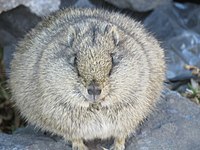Cavia tschudii
The poronccoy (from southern Quechua purun quwi, "wild guinea pig"), wild guinea pig, Wild guinea pig or Serrano guinea pig (Cavia tschudii) is a species of rodent in the family Caviidae native to the Andes of Peru, from Bolivia, Chile and Argentina, is probably the main ancestor of Cavia porcellus, the domestic guinea pig, which appears to be a hybrid that includes minor genetic contributions from other Cavia species.
Description
The wild guinea pig is a medium-sized species, reaching a total length of 247 mm. Its color varies in the different parts of the cordillera; in Peru, the upperparts are dark reddish-brown mixed with black, and the underparts are dark buffy-grey; in Chile, dorsal surface pale agouti brown with paler underparts; in Bolivia, the upperparts are agouti-olive and the underparts creamy-white or white.
Distribution and habitat
The wild guinea pig is native to the high Andes in South America. Its range extends from Peru and Bolivia south to the Tarapacá region of Chile and the Tucumán province of Argentina. Its altitude range is 2,000 to 3,800 meters above sea level. It lives in humid habitats with rocks and thick vegetation, making paths through the foliage. In Argentina it lives in burrows with several entrances.
Life Cycle
The wild guinea pig has a gestation period of around 63 days. Litter sizes range from one to four, and the young grow rapidly, becoming independent by 2 months of age.
Taxonomy
Wild Peruvian guinea pigs were first described by Edward Turner Bennett in 1835, who named them Cavia cutleri. Johann Jakob von Tschudi, in a publication from 1845, used the term Cavia cutleri to refer to what are now considered two distinct species: the first, Bennett's Cavia cutleri, which was later identified (by Oldfield Thomas in 1917) as probably a version of Cavia porcellus with a different pigmentation, and the second, a wild Peruvian guinea pig that was clearly different from the animal described by Bennett. In 1867, Leopold Fitzinger renamed the clearly wild guinea pig Cavia tschudii.
Subspecies
Within the species, six to eight subspecies are described along with the nominate form. The following account follows Dunnum (2015) with eight subspecies, pending revision according to the author.
- Cavia tschudii tschudii: Subspecies type, in the Ica region of Peru; coloration of the greyish body cinnamon
- Cavia tschudii atahualpae: In the valleys of the Andes in northern Peru. Large and coloured cinnamon dark grey to black. The sides of the body are lighter than the back.
- Cavia tschudii festina: In the Andean region of central Peru, in the region of Junín. Coloring the grey-canel body.
- Cavia tschudii osgoodi: In southern Peru, in the Altiplano, north of Lake Titicaca. Dark reddish brown body coloring.
- Cavia tschudii pallidio: In the lowlands of northern Chile and southern Peru to the high altitudes of Bolivia.
- Cavia tschudii sodalis: In the highlands of the provinces of Tucumán and Jujuy in northern Argentina, previously also in the province of Salta. Animals are pale brown.
- Cavia tschudii stolida: In the Utcubamba valley in the northwest of Peru. Dark olive brown body coloring.
- Cavia tschudii umbrata: In the Andean region of central Peru, in the region of Junín. Colour of the grey-black body.
Wilson & Reeder (2005) only distinguish six subspecies. C. tschudii atahualpae, C. tschudii pallidior and C. tschudii umbrata are not considered there, the subspecies C. tschudii arequipae occurring there is considered a synonym of Cavia tschudii pallidior according to Dunnum (2015). C. tschudii stolida is considered partly a separate species.

